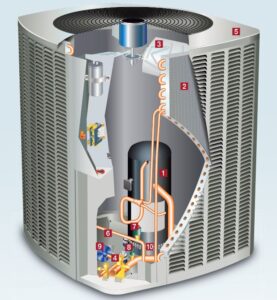This isn’t my invention. One of my students told me that her dad built a system to use the heat from the central air conditioning heat pump to warm the water for their swimming pool.
In engineering , everything is a trade-off. It’s good practice to look for the downside, but in this case, there aren’t many that are obvious.

This is a typical heat pump for a home central air conditioner. Just inside the housing, there are four condenser coils. They look like a car radiator. They get hot. A big, fat-ass fan on top, pulls warm, outside air across those coils, and expels even hotter air straight up.
There are a few other things inside. A compressor and some electronics. The only connections to the condenser coils are a few copper tubes and a few wires for sensors.

With the assistance of an HVAC guy, the condenser coils could be submersed in a tank of water. The water tank gets cool water from the swimming pool and returns warm water to the swimming pool. The other elements of the heat pump would not be submerged.
The fat-ass fan is no longer needed. Water has a tremendous ability to absorb heat. Water at 75 degrees would absorb the heat from the condenser coils much more efficiently than 90 degree air. The heat pump would work better.
The pool already has a water pump for filtration. Wire the water pump to activate when the air conditioning turns on.
A pool heater supplies about 30,000 Watts, while an air conditioner heat pump dumps about 10,000 Watts of heat. In Ohio, an unheated swimming pool doesn’t get to a comfortable temperature until about July, while air conditioning may be used occasionally in April.
This configuration would extend the usable time of the pool while the heat pump runs more efficiently. There doesn’t seem to be much of a downside in an area like Ohio.
To me, that’s how environmentalism should work. Life should be improved while we use resources better.